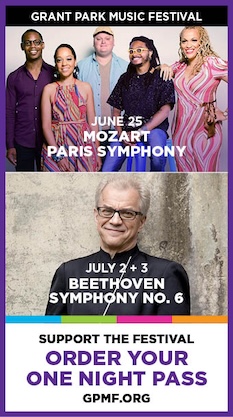Kalmar, Grant Park Orchestra shine in music of Frank, Prokofiev

The Grant Park Orchestra is concluding its second week doing what it does best: roving widely through novel, familiar, and lesser-known repertoire under the assured leadership of outgoing artistic director Carlos Kalmar.
Friday night’s program opened with the first Grant Park Orchestra performances of Gabriela Lena Frank’s Apu: Tone Poem for Orchestra, written in 2017 for the National Youth Orchestra of the United States of America. Like much of Frank’s oeuvre, the 15-minute Apu is informed by her multiethnic heritage, in this case drawing on her Peruvian roots.
In Quechua folklore, an apu is an Andean spirit-imp that mountain travelers must appease with small offerings of music or food to ensure safe passage. Frank’s score proceeds in three attacca movements, beginning with “Pinkillo Serrano.” A ‘pinkillo’ is a small, packable flute that travelers might use to placate the titular spirit, and modal piping from the flute section runs through the movement, joined by the strings and punctuated with pizzicati and percussion. The more extended central “Haillí” offers an unsettled nocturnal soundscape meant to evoke a supplication to an apu, and recalls passages of Bartók. (Frank is also of Eastern European extraction.)
In the final movement the apu itself appears, its mercurial hijinks conveyed in Frank’s quicksilver writing. A passage of languid glissandi appears just before the end, when the apu evaporates back into the mountains, captured with a final strike on the woodblock. Kalmar presided over an intricate reading of this evocative and atmospheric score.
American pianist Garrick Ohlsson was the evening’s soloist in Schumann’s Piano Concerto in A Minor, Op. 54. Ohlsson is a stalwart veteran of the concert stage, whose performances have been reliably inspired for decades, though Friday night’s Schumann felt like it was going through the motions.

Ohlsson took a spacious approach to the Allegro affettuoso, playing with fluency if not much fire. There was little interaction between soloist and orchestra, lamentable as this was precisely what Schumann sought to rectify. (“We must await the genius who will show in a new and more brilliant way how the orchestra and piano may be combined,” he wrote.) The brilliant cadenza felt more cautious than anything.
Ohlsson’s restrained approach was better suited to the lyricism of the Intermezzo, engaging in supple dialogue with the cello section. The Allegro vivace felt staid and somewhat stiff albeit with a certain gravitas. Given a summer program framed by two complex works, it is easy to imagine the most standard of concertos having gotten the short end of rehearsal time.
As an encore Ohlsson offered a subtle, eloquent account of Chopin’s Nocturne in E-flat Major, Op. 9, no.2, playing with a rich palette that even came across the Pritzker Pavilion’s amplification. The encore showcased Ohlsson’s artistry more effectively than the concerto and showed why he still remains the only American to have won First Prize at the International Chopin Piano Competition, 54 years after the fact.
The evening concluded with Prokofiev’s Symphony No. 6 in E-flat Minor, Op. 111. Completed in 1947 in the wake of WWII, the work was hailed by Soviet cultural apparatchiks at its premiere only to be condemned as an instance of unforgivable “formalism” two years later, a typical instance of the regime’s arbitrariness.
While the three-movement, 45-minute Sixth does not offer up its rewards as readily as its inescapable precursor, it shows Prokofiev at the height of his powers grappling with the immediate aftermath of world’s deadliest conflict.
Kalmar’s inspired navigation Friday made the strongest possible case for the Sixth’s considerable merits. A palpable unease pervades the opening Allegro moderato, and Kalmar captured the throughlines of its uncertain wandering, eliciting superb playing across the orchestral sections. In the central Largo gleaming melodies suffused with crunchy dissonance contrast with passages of pointed angularity, which Kalmar wove together into a convincing narrative. The sardonic Vivace went with brilliant momentum, Kalmar and colleagues capturing its carnivalesque elements and racing to the work’s conclusion, delivering its clangorous penultimate chord with jarring, brutal force.
The program will be repeated 8 p.m. Saturday. gpmf.org
Posted in Performances


Posted Jun 28, 2024 at 12:37 pm by Steve R.
Although the Grant Park Orchestra and their programs are generally very good, I’ve had it with the Pritzker Pavilion as a venue for classical music. It just can’t compete with the constant onslaught of noise from the city. Jets flying directly overhead every two minutes. Unnecessarily loud and too-frequent sirens. Hot rods. Loud radios. Loud voices. And worst, omnipresent helicopters.
Both the conductor and the pianist remarked on the noise in separate comments. Add to that a starting time when few of the seats are in the shade on a 90 degree day, and you have a recipe for a bad experience. I’ve had enough.